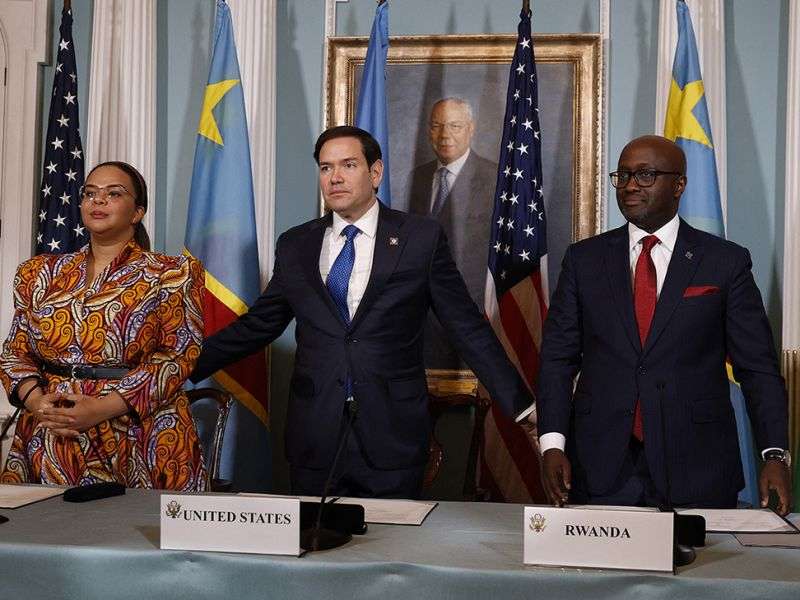The June 27 peace accord, which Kinshasa and Kigali are preparing to sign, has greater consequences than merely a strategic solution, including lessons for Africa’s security architecture and discussions regarding the future of the mineral-rich eastern DRC.
The impetus for M23’s advance and control was the claim that Rwanda moved approximately 4,000 troops across the border, a claim that Rwanda has denied. The DRC government severed diplomatic relations in January 2025 following the confirmation from a United Nations report of that troop activity. The region is extremely unstable given potential high value mineral reserves, including cobalt, coltan, lithium, gold and copper, which are critical to the global supply chain for electronics, electric vehicles or green technologies.
Efforts to mediate the conflict extended through Angola, the East African Community (EAC), and UN mechanism but each attempt failed and the humanitarian cost continues to rise: over seven million displaced people and widespread abuse as described by both Amnesty International and various UN Specialized agencies.
Ongoing Developments: The Signatories to the June 27 Peace Deal
On June 27, DRC President Félix Tshisekedi and Rwandan President Paul Kagame intend to sign an important peace treaty in Washington, based on US and Qatari mediation.
Among the key provisions:
- Respect for territorial integrity and a complete exhaustion of hostilities.
- Total withdrawal of Rwandan troops and other equipment ahead of the implementation of the instant agreement, Rwanda is pushing back, due to security threats from other armed groups.
- Disarmament and conditional integration of M23 and allied militias into DRC forces, dependent on security reforms.
- Return of the refugees and enhanced access for humanitarian actors in eastern DRC
- Coordination through a Joint Security Coordination mechanism that follows the previous Angolan framework
- A commitment to a regional economic integration agenda, indicating an interest in resource governance and investment, therefore, unlocking the weakly conditional Western capital fired often lazily by US officials as “This is a win-win.” This treaty followed rushed diplomacy from Washington on what is often referred to as a shrewd timing and diplomatic event, where the Trump administration fine-tuned involvement and Qatari hosting expedited urgency, seriousness and timeline.
Current Conditions and Risk
The UN peacekeepers (MONUSCO) have re-engaged and deployed their coordination teams to Goma, but they received criticism for the limitations on their mandate. Meanwhile, multinational companies have shut down operations: Heineken left Goma and Bakavu because the violence against staff and facilities increased. This agreement, like previous agreements, will collapse if Kigali does not withdraw its troops or if M3 rejects integration with the Congolese army.
Uncertainty and instability in Eastern DRC would spill over into Burundi, Uganda or Rwanda resulting in more refugees, more insecurity, worsening humanitarian tragedies in the region and disruptions to all resource supply.
Future Prospects: Promise, Pitfalls and Lessons
- Resource security and Economic Opportunity
If peace prevails, it could enable Western and US investments in mineral extraction in the DR Congo, which is vital to support transitions to a more green economy and resilient supply chains. A stable Eastern DR Congo could generate multi billion dollar mining deals with the potential to redirect global supply away from China and rogue actors.
A Template for African Security Architecture
- Success or failure of the agreement will be a measure of Africa’s ability to resolve conflict through regional and multilateral frameworks. The experience with EAC, SADC and UN peace efforts yields key lessons:
-
- Early political buy-in is critical – Without Rwanda’s ministerial approval, the agreements made earlier were dead on arrival.
- Integration of rebel groups must be accompanied by broader security sector reform in DRC, without broader reform, disarmament will not happen.
- Sustainable peace must have economic incentives, not just troop lines, the regional investments clause is core to sustainable peace.
International & Regional Consequences
If successful, the agreement coils de-escalate the risk of transnational militias, stabilize markets, and free up humanitarian access. However, global actors should be adamant about implementing the agreement: delays in UN funding, cutbacks in US foreign assistance, and blushes on justice investigations as a permanent solution to conflict, it it possible that DRC changes both the direction of its engagement to which it is currently heading away from Rwanda, and strengthen its leverage in negotiations with China, the West and India.
On paper, this peace agreement is a major step forward in restoring regional order and assuring mineral and energy resource security. Its mere text coming together around respect for territorial integrity, security arrangements and economic components of the deal suggests a comprehensive approach rarely, if ever, seen in Africa. The agreement is also notably marked by US strategic interests in stabilizing supply lines for strategic minerals and reducing Western dependence on transport routes to China. There remain significant risks associated with a range of factors, capacity to implement, political will to act, as well as sustained regional or international oversight.
The peace deal may falter if rebels feel marginalized, local ethnic groups assert claims to the regional transports, and if funding from the UN remains precarious. If, however, the signing on June 27 triggers a formal security mechanism for the M23 insurgency to withdraw from Goma and monitors remain, linked to investments, this could lead to a quiet but seismic change for eastern DRC. It even has the potential to provide a proof-of-concept for Africa that peace requires requisite arrangements: legal, economic and security arrangements that all work together.
The peace agreement on June 27 between the DRC and Rwanda represents a critical turning point for Eastern Congo and Africa’s wider security situation. It is more than a ceasefire; it is a peace agreement designed in a manner linking stability to investment, sovereignty to integration, and local voices to regional structures. For resource-rich but conflict-engendered regions in Africa, this signifies a model of hope: one of peace based on structural integration and accountability-perfect if deadlines are met, troop withdrawal happens and all parties remain engaged after the ceremony.

